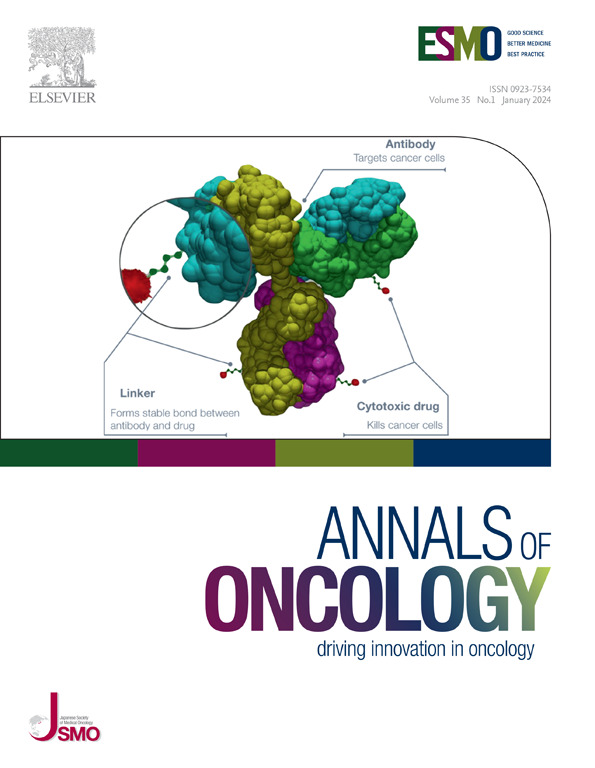奥拉帕利一线治疗后复发的晚期卵巢癌患者后续治疗的疗效:PAOLA-1/ENGOT-ov25 试验结果。
IF 56.7
1区 医学
Q1 ONCOLOGY
引用次数: 0
摘要
背景:晚期卵巢癌患者越来越多地使用一线PARP抑制剂维持治疗。了解一线治疗中疾病进展患者的首次后续治疗(FST)疗效对于优化进展后治疗非常重要。我们评估了PAOLA-1/ENGOT-ov25(NCT02477644)中接受奥拉帕利一线维持治疗的患者的FST疗效:这项事后分析评估了疾病进展后后续化疗的疗效,根据进展发生在奥拉帕利一线维持治疗期间还是之后以及FST类型,评估了从FST到第二次后续治疗(SST)的时间。在奥拉帕利加贝伐珠单抗治疗组中使用了多变量Cox模型,以确定影响后续化疗疗效的预后因素:在806名随机患者中,544人(67.5%)病情进展并接受了后续化疗。奥拉帕利加贝伐珠单抗治疗组患者从FST到SST的中位时间在奥拉帕利一线维持治疗期间出现进展的患者(6.1个月)短于奥拉帕利一线维持治疗后出现进展的患者(11.4个月)。多变量分析表明,一线奥拉帕利维持治疗后(与一线奥拉帕利维持治疗期间)的进展影响了从FST到SST的时间(危险比为0.65,95% CI为0.50-0.84;P=0.0011),与无铂间隔或临床风险无关。在进展期接受铂类化疗并同时使用PARP抑制剂作为FST的患者中,后续疗法的疗效也取决于进展是发生在一线奥拉帕利维持治疗期间还是之后:这些结果表明,相对于一线奥拉帕利维持治疗而言,疾病进展的时间可能会影响后续铂类化疗的疗效。尽管对结果的解释应谨慎,但在所有亚组中,包括在接受铂类化疗的同时接受PARP抑制剂再挑战作为FST的患者,如果疾病进展发生在一线奥拉帕利维持治疗期间,则从FST到SST的中位时间要长于一线奥拉帕利维持治疗期间。本文章由计算机程序翻译,如有差异,请以英文原文为准。
Efficacy of subsequent therapies in patients with advanced ovarian cancer who relapse after first-line olaparib maintenance: results of the PAOLA-1/ENGOT-ov25 trial
Background
The use of first-line poly(ADP-ribose) polymerase (PARP) inhibitor maintenance therapy is increasing in advanced ovarian cancer. Understanding the efficacy of first subsequent therapy (FST) in patients experiencing disease progression in the first-line setting is important to optimize postprogression treatments. We evaluated the efficacy of FST in patients from PAOLA-1/ENGOT-ov25 (NCT02477644) who received first-line olaparib maintenance.
Patients and methods
This post hoc analysis evaluated the efficacy of subsequent chemotherapy following disease progression by assessing time from FST to second subsequent therapy (SST) according to whether progression occurred during versus after first-line olaparib maintenance and FST type. A multivariate Cox model was used in the olaparib plus bevacizumab arm to identify prognostic factors influencing the efficacy of subsequent chemotherapy.
Results
Of 806 randomized patients, 544 (67.5%) progressed and received subsequent chemotherapy. The median time from FST to SST was shorter in patients in the olaparib plus bevacizumab arm who progressed during first-line olaparib maintenance (6.1 months) than in those who progressed after first-line olaparib maintenance (11.4 months). Multivariate analysis indicated that progression after (versus during) first-line olaparib maintenance influenced time from FST to SST (hazard ratio 0.65, 95% confidence interval 0.50-0.84; P = 0.0011) independently of platinum-free interval or clinical risk. Among patients who progressed and received platinum-based chemotherapy with a PARP inhibitor as FST, the efficacy of subsequent therapies was also dependent on whether progression occurred during versus after first-line olaparib maintenance.
Conclusions
These results suggest that the timing of disease progression relative to first-line olaparib maintenance may impact the efficacy of subsequent platinum-based chemotherapy. Although results should be interpreted with caution, across all subgroups, including patients who received platinum-based chemotherapy with PARP inhibitor rechallenge as FST, the median time from FST to SST was longer if progression occurred after versus during first-line olaparib maintenance.
求助全文
通过发布文献求助,成功后即可免费获取论文全文。
去求助
来源期刊

Annals of Oncology
医学-肿瘤学
CiteScore
63.90
自引率
1.00%
发文量
3712
审稿时长
2-3 weeks
期刊介绍:
Annals of Oncology, the official journal of the European Society for Medical Oncology and the Japanese Society of Medical Oncology, offers rapid and efficient peer-reviewed publications on innovative cancer treatments and translational research in oncology and precision medicine.
The journal primarily focuses on areas such as systemic anticancer therapy, with a specific emphasis on molecular targeted agents and new immune therapies. We also welcome randomized trials, including negative results, as well as top-level guidelines. Additionally, we encourage submissions in emerging fields that are crucial to personalized medicine, such as molecular pathology, bioinformatics, modern statistics, and biotechnologies. Manuscripts related to radiotherapy, surgery, and pediatrics will be considered if they demonstrate a clear interaction with any of the aforementioned fields or if they present groundbreaking findings.
Our international editorial board comprises renowned experts who are leaders in their respective fields. Through Annals of Oncology, we strive to provide the most effective communication on the dynamic and ever-evolving global oncology landscape.
 求助内容:
求助内容: 应助结果提醒方式:
应助结果提醒方式:


